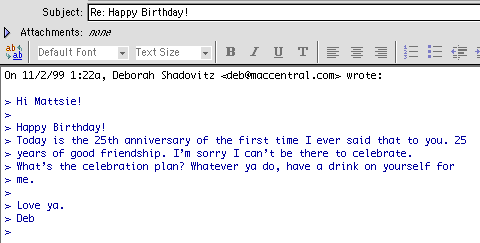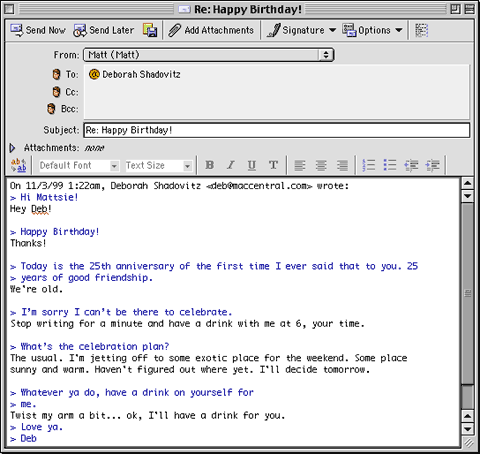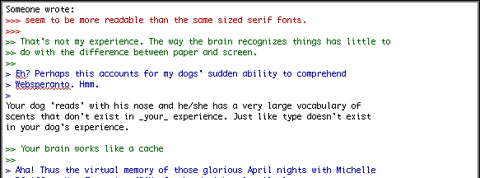|
||||
E-mail Efficiency Part 5: The ReplyWritten and published November 3, 1999 Last week we discussed the two ways you can format e-mail: plain text and HTML. The day after that column published, by coincidence, a "professional" head of a "top, creative" Internet design firm" posted to a list I'm on, advertising a job opening announcement (seeking smart people) -- and posted it in HTML with graphics. Let's just say the responses echoed last week's reader response. And on that note, we move on to the topic of replying to e-mail. Since I'm an advocate of plain text e-mail, and it's what you should be using most often, we'll focus on replying to plain text messages. On Wednesday, November 3rd, Deb said:Let's start at the very beginning (a very good place to start). When you learn to talk you speak, then me (ok, "I" but I was on a roll with the Sound of Music thing). Seriously, in conversation we take turns speaking. One person says something and another responds. The same is true with e-mail. But with e-mail, we also repeat the question, so to speak. For example, let's say I write this message:
When Matt gets my message, and wants to respond, he hits "Reply." (Every e-mail program has reply command.)
So here's what Matt's response would look like when he first hits reply:
What's next? It's time for Matt to write his response. Now we come to a style issue. There are 3 ways he can reply (besides picking up the phone).
Begin by reading the entire message before starting your reply. Otherwise you may be replying to something that's covered later on and you've wasted your time. Then, place your cursor where you want to type. (It is probably waiting for you at the end of the quoted text. That's a preference you can set in most e-mail apps.) Any line that was blank in the incoming message will have a ">" in it now. Delete that reply marker and enter your own text. If the message looks crowded and busy, press Return after your response to put some space between your response and the next thought. If a new thought begins mid-paragraph, or if you just want to comment to a particular sentence, insert your cursor after the end of the thought you're responding to and press Return a couple of times. Then, on the first new line after the thought, type your response to those words. Don't begin typing on the same line as the message you're replying to. Whenever you type, be sure not to have a quote character (>) in front of your text or it'll look like the original message's words instead of your own. After you do a few messages you'll get used to the quote marks and see how they work. Take a look at this reply to see how it shapes up.
Notice that in the above example, because I broke up a line, there's a shortened line and one word (me) hanging out alone. This isn't due to long lines. It's from breaking up a line. You can "rewrap" that paragraph if you want to. To do this, select those two lines and look for a rewrap lines command. (We covered this a few weeks ago. In OE you can Control-click and find the command in the contextual menu that appears. Eudora also has a rewrap command.) Re-wrapping will move those two lines together and remove the extra resulting blank line. As a message goes back and forth, or as a quoted message is quoted again, quote characters are added. Most programs change the color of the text for each quote level to help you see who said what. This next message is an example of a post to a list that has a quote that was quoted being quoted yet again. The black text is always the newest.
Sometimes you may feel it more appropriate to put a full response at the top of a quoted message instead of quoting between lines. However, when do this you'll have to respond to issues more like you do in a letter, repeating some of the issues so your response makes sense. And if you do, don't forget to still be selective about what you quote. (See below.) I'm not a fan of adding a response beneath the quoted text. This forces readers to have to scroll past the old stuff in order to get to the new. This is especially horrible when the entire long message is quoted. Never do that to a person. And definitely never do that on a list. Whatever style of quoting you decide to use, just make sure you DO QUOTE. In a real conversation, you're one-on-one with a person and the words are fresh in your minds. However, conversing with e-mail is like having several (or very many) conversations at once. A message that gives an answer can be a puzzle to the recipient if he doesn't recall the question. Don't take chances and don't force the recipient to go through previous messages on a thought hunt. Quoting is courteous. Remove excess baggageI can't stress enough that you shouldn't burden your reader with extraneous lines of text. As I've said, don't quote unnecessary words. If you're cutting out a bunch of paragraphs you can insert "<snip>" to let people know you've removed something. However, any words you're referring to should be quoted. One thing that really bugs me is seeing signatures and other tag lines (especially long ones) quoted, then included and quoted again, and even again. When someone writes to you, his signature is not something you need to quote back to him. He knows who he is. Email lists typically put informational tags at the bottom of all posts. When you reply that same tag will be added so there is NO reason to quote the one on the message you're responding to. I promise. Next WeekNext week we'll talk more about e-mail composition. Specifically, replying and forwarding messages. The week after, I think we'll put the finishing touches on the e-mail topic. I can use the help of those of you who are e-mail old-timers: if you have a favorite abbreviation or emoticon, please let me know. We can have a lot of fun with that column. |
||||



